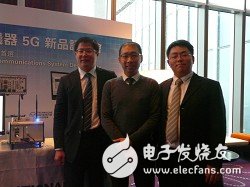End-users' demand for high-bandwidth, high-speed networks is growing, and with 2020, 50 billion connected devices will be put into operation, making 5G technology development a reality. In order to implement this technology, related communication system design engineers need time-saving and easy-to-use development tools to verify the possibility of current 5G emerging technologies. National Instruments (NI) introduced the LabVIEW Communication System Design Group, which combines software radio ( SDR) hardware and software design flow saves engineers the time to convert different programming languages ​​and accelerate the production of 5G system prototypes.

From left to right, Lin Peiyan, general manager of National Instruments Taiwan, Guo Huangzhi, general manager of marketing in Greater China, and Pan Jianan, technical marketing manager
Guo Huangzhi, general manager of National Instruments Greater China Marketing, said that in the past, the distance from 2G to 3G was quite long, while 3G evolution to 4G took only 4 to 5 years. As for 5G, it is expected to be available in 2020. R&D time is getting more and more urgent.
Not only that, the industry's definition of 5G technology has not yet matured. At present, it is only known that it will develop large-scale multiple input multiple output (Massive MIMO) antennas, widely distributed base stations, improved modulation technology, and the use of millimeter waves (mmWave). The direction is to start research; however, each technology has to go through a fairly complex process from algorithm to prototype (Prototype), so there is no need to use a high-performance development platform to verify technical feasibility and speed up prototyping.
In order to promote 5G technology, National Instruments proposed a highly integrated software and hardware solution--LabVIEW communication system design team, which can solve the problems faced by today's R&D personnel from the perspective of system level and greatly reduce their development time.
Pan Jianan, National Instrument Technology Marketing Manager, further explained that SDR's hardware circuit architecture includes central processing unit (CPU) / general purpose processor (GPP), field programmable gate array (FPGA) / digital signal processor (DSP), And RF Front-end and other three parts, so it is often necessary to use different technical teams for development, and the programming language and development tools used by FPGA and processor are different, which makes the system mapping difficult. From algorithm development to prototype completion, it often takes more than a year.
In view of this, the LabVIEW Communication System Design Group not only enhances the ability to seamlessly convert between different algorithm design languages, but also provides a hardware-aware design environment that provides entity setting control, hardware limitations, and system-building files through functional software diagrams. This allows designers to be creative and not distracted by the details, further improving the speed and quality of prototyping.
In fact, the current 5G network, measurement technology and standard setting are all running at the same time. Not only telecom and measurement related manufacturers have swarmed, but also standard research organizations have emerged. Recently, 5G World Alliance That is, it was officially launched at MWC in 2015; the organization will focus on developing next-generation wireless network technologies to meet future M2M, SDN and mobile cloud computing applications, and to achieve a connected environment with everything connected.
Create the next generation mobile network 5G global alliance officially establishedLatif Ladid, founding chairman of 5GWA and chairman of the IPv6 Forum, pointed out that 5G technology can bring everyone and goods into the Internet of Things world. The so-called 5G world system integrates fixed network and mobile network technologies, such as M2M based on IPv6 architecture. Animal networking, mobile cloud computing, SDN, Network Function Virtualization (NFV), etc., to change all life and business models. 5GWA is a key player for professional organizations and users and vendors looking to emerge from emerging network solutions.
5GWA also hopes to push 5G technology to different industry categories. Ladid further pointed out that the world in 2020 will integrate many important infrastructures, such as health care, transportation and agriculture, so 5GWA will begin to try to enter these industries in order to import the needs of all walks of life from the beginning into the 5G framework.
Currently, 5GWA is working closely with the European Telecommunications Standards Institute IPv6 Industry Specification Group (ETSI IPv6 ISG) to integrate telecommunications and the Internet, and with standards development organizations such as 3GPP, ESTSI, Internet Engineering Task Force (IETF) and The International Telecommunication Union (ITU) shares best practices.
BLPS laser safety protective device is designed for personal safety used on hydraulic bender.
The dynamic test technology it used has passed the Type 4 functional safety assessment by TUV, and get the national invention patent. The product reaches the advanced technological level of similar products.
BLPS laser safety device provides protection zone near the die tip of the bender to protect fingers and arms of the operator in close to the upper mold die tip. It is the most effective solution so far to preserves the safety and productivity of the bender.
Press Brake Protection,Laser Guarding Device,Press Brake Guarding Systems,Press Brake Guarding
Jining KeLi Photoelectronic Industrial Co.,Ltd , https://www.sdkelien.com